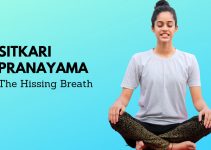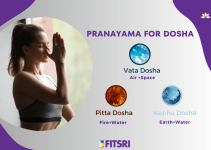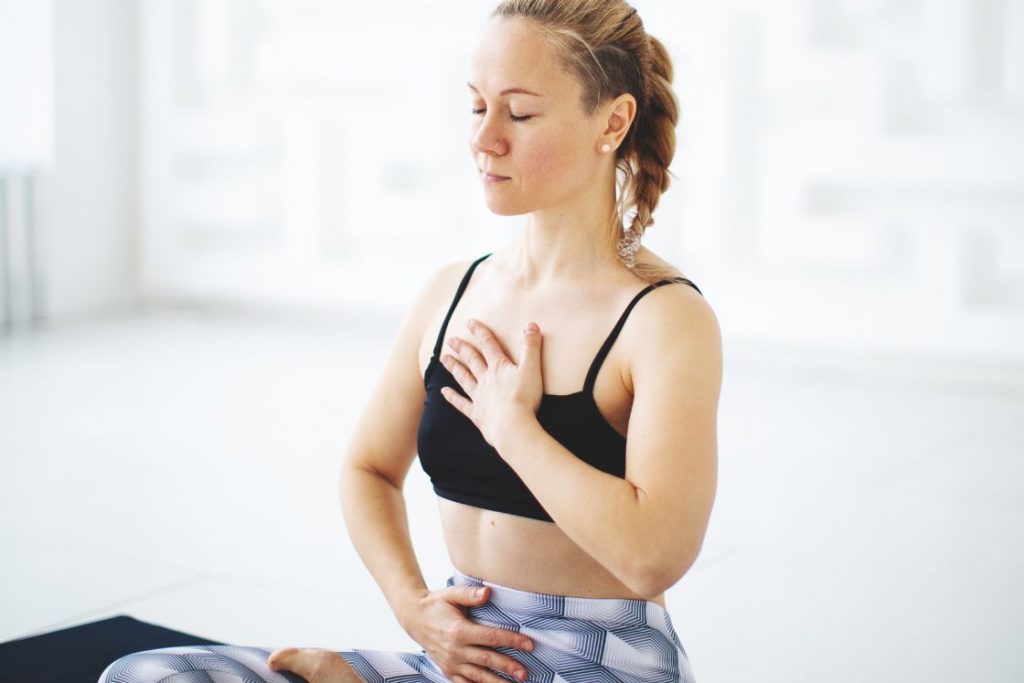
Almost everyone, from teenagers to the elderly, is highly affected by high blood pressure, which is a very common ailment.
A higher occurrence of high blood pressure has been linked to poor lifestyle choices such as eating the wrong things, being inactive, and having trouble sleeping. Stroke and heart disease are more likely to affect those with high blood pressure.
Yoga can help lower blood pressure by bringing these lifestyle changes: exercise, maintaining a healthy weight, and stress reduction.
Pranayama, a part of yoga that deals with breathing and its regulation, is highly effective to control blood pressure. It plays a vital role in calming the mind, stabilizing the heart rate, and increasing lung capacity, all of which can directly lower blood pressure.
In this article, we will discuss which pranayama is good for high blood pressure, how it works, and which pranayama one must avoid in case of hypertension.
What is high blood pressure?
When your blood pressure is higher than the normal range, it is typically called high blood pressure (also known as hypertension). Before understanding the situation of high blood pressure, we should first understand what is normal blood pressure.
The force of blood against the artery walls is known as blood pressure.
Two numbers are used to determine blood pressure:
- Systolic blood pressure is the first number, and it represents the pressure in your arteries while the heart beating.
- Diastolic blood pressure, or the second number, gauges the pressure in your arteries between heartbeats.
You would say “120 over 80” or write “120/80 mmHg” if the measurement was 120 systolic and 80 diastolic.
Symptoms of high blood pressure
Even when blood pressure measurements are extremely high, most persons with high blood pressure don’t exhibit any symptoms. Without showing any signs, high blood pressure can exist for years. This is also the reason it is known as the “silent killer”.
However, a few people might exhibit the following symptoms:
- Headaches
- Shortness of breath
- Nosebleeds
- Sweating
- Facial Flushes
The majority of the time, they don’t show up until high blood pressure has become serious or life-threatening. You are putting at risk your life if you disregard your blood pressure in the hope that another symptom or sign would make the issue obvious.
Keeping a regular check on your blood pressure by either going to a healthcare professional or measuring it at home with a BP machine is the best way to keep your BP in check.
Problems due to high blood pressure
The harm increases as blood pressure rise and remains uncontrolled for a longer period. Important organs including your heart, brain, kidneys, and eyes might suffer severe damage. High blood pressure damages blood vessels and internal organs by placing an excessive amount of pressure on the artery walls.
You may experience complications like:
- Heart attack, heart failure, heart disease, or stroke
- Aneurysm
- Chest pain
- Chronic kidney disease
- Thickened, narrowed, or torn blood vessels in the eyes
- Metabolic syndrome
- Reduces cognitive ability
- Dementia
How pranayama helps in lowering high blood pressure?
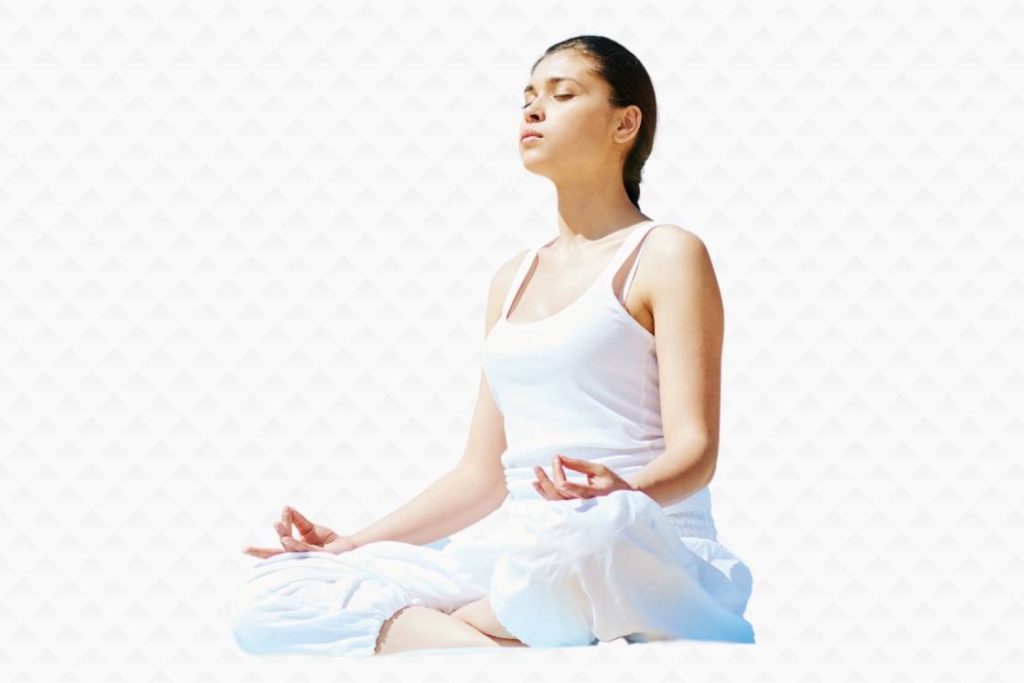
One direct aspect of pranayama’s effective working for high blood pressure comes from its ability to activate the parasympathetic nervous system.
When we do pranayama which involves slow and deep breathing, our parasympathetic nervous system (rest-and-digest system) gets activated. The activation of the parasympathetic nervous system immediately sends relaxing signals to the brain resulting in a decrease in heart rate and dilation of blood vessels. This results in easy flow of blood in artery walls and hence reduces high blood pressure.
The respiratory and cardiovascular systems are closely related. Consciously controlling the breath through pranayama positively affects cardiovascular indicators such as chest pressure, blood vessels widening, etc. This is due to the fact that different types of pranayama breathing create variations in heart rate, which in turn directly impacts blood pressure.
The physiological effects of pranayama are designed to be therapeutic. It unites the body and mind and gives the body oxygen while expelling toxins. Pranayama’s stress-relieving qualities enhance sleep quality, boost mindfulness, and lower blood pressure.
Pranayama for high blood pressure
Patients suffering from high blood pressure should first check in with a medical professional to get the proper diagnosis. Only then they should start with alternative practices like pranayama. Though time and again pranayama has been proven to be beneficial for most ailments, one should always learn the correct from a teacher before performing on their own.
1. Bhramari Pranayama (Humming Bee Breath)
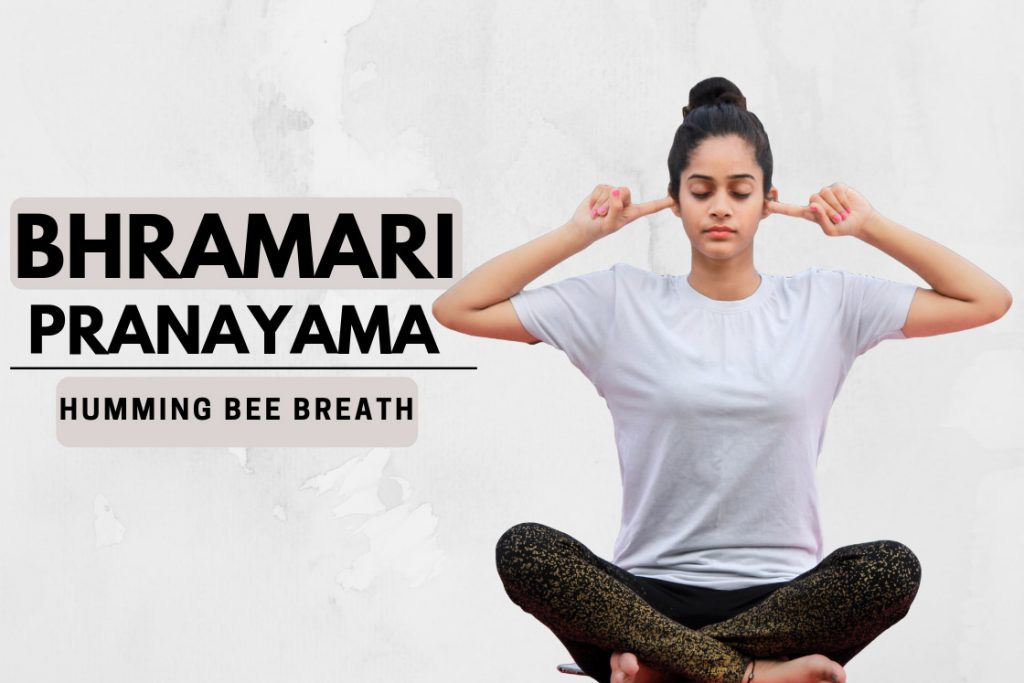
Bhramari Pranayama is also known as “Humming Bee Breath” because the humming sound we make when practising sounds like the buzzing of a bee. By creating internal vibrations, this pranayama deeply unwinds the body and brain. It lowers blood pressure and eases tension and anxiety.
According to research from 2010, doing Bhramari pranayama at a slow breathing rate of three breaths per minute for five minutes can lower high blood pressure and cause a small drop in heart rate (2-3 beats). Additionally, it helps pregnant women avoid pre-eclampsia.
Another study in 2022 determined that simple Bhramari Pranayama dramatically lowered blood pressure and pulse rate in both hypertensive and normotensive volunteers within minutes of using it.
Steps to perform
- Sit in your preferred meditation position in a peaceful location on a comfortable surface.
- Maintain a comfortable straight back and a spine-aligned head position.
- Put your index fingers on the tragus, the projecting cartilage on the exterior of the ear, to partially shut the ear. You can fold the remaining fingers within your palm.
- Breathe in via your nose.
- Close your ears by pushing the cartilage inwards, slightly tuck in your chin (jalandhara bandha), and exhale while creating a “hmmmmm” sound at the back of your throat.
- Repeat for 5-7 minutes.
2. Nadi Shodhana (Alternate Nostril Breathing)
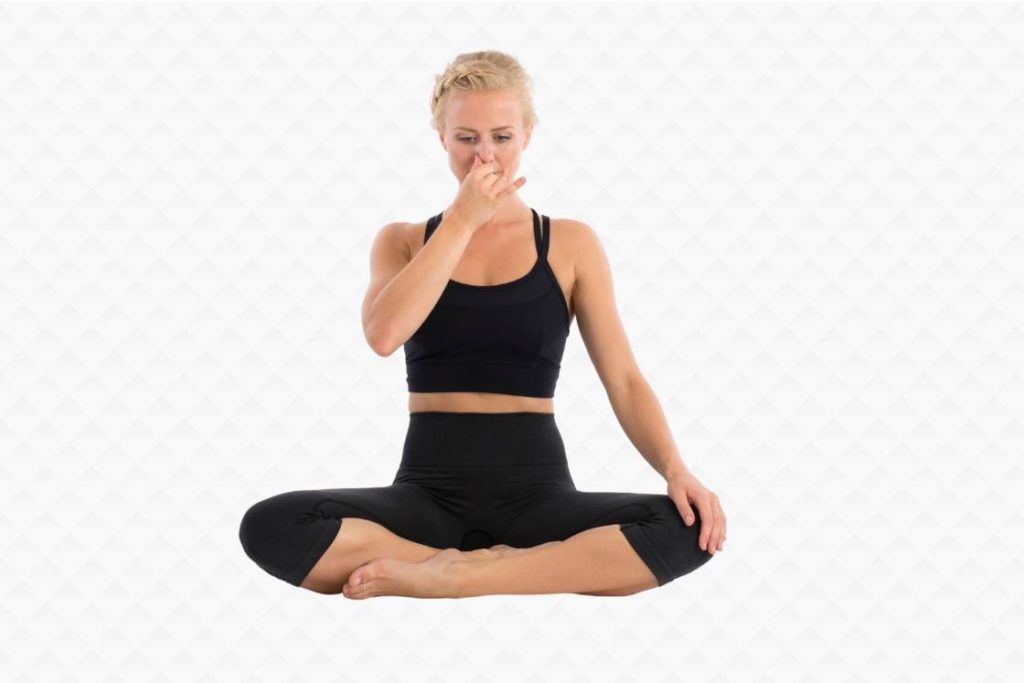
To purify the Nadis from all pollutants, Nadi Shodhana is a purifying pranayama breathing technique. Deep breathing in this pranayama enhances blood circulation throughout the body, allowing the muscles, lungs, heart, and other organs to work optimally. It strengthens your lungs and restores your nervous system. High blood pressure, asthma, and migraines can all be effectively treated with it.
Steps to perform
- Sit comfortably for meditation, trying to keep your back as straight as you can. If sitting on the floor bothers you, you can sit on a cushion, a folded blanket, or a chair.
- Put your left hand in the Gyan mudra position on your thigh. Your right hand should be brought up close to your face.
- Fold the index and middle fingers while placing the thumb on the right nostril. Place the ring and little finger close to the left nostril. To open and close the nostrils, the thumb, ring, and little finger will function as lids.
- For a few seconds, breathe normally to steady your breath.
- Breathe in via your right nostril while closing your left nostril with your ring finger.
- Breathe out entirely while opening your left nostril.
- Inhale while keeping the left nostril open and keeping your right nostril closed with your thumb. Release the thumb from the right nostril and completely exhale via the right nostril.
- This completes one round of nadi shodhana.
- Practice at least 2-3 rounds.
3. Chandra Bhedana Pranayama (Left Nostril Breathing)
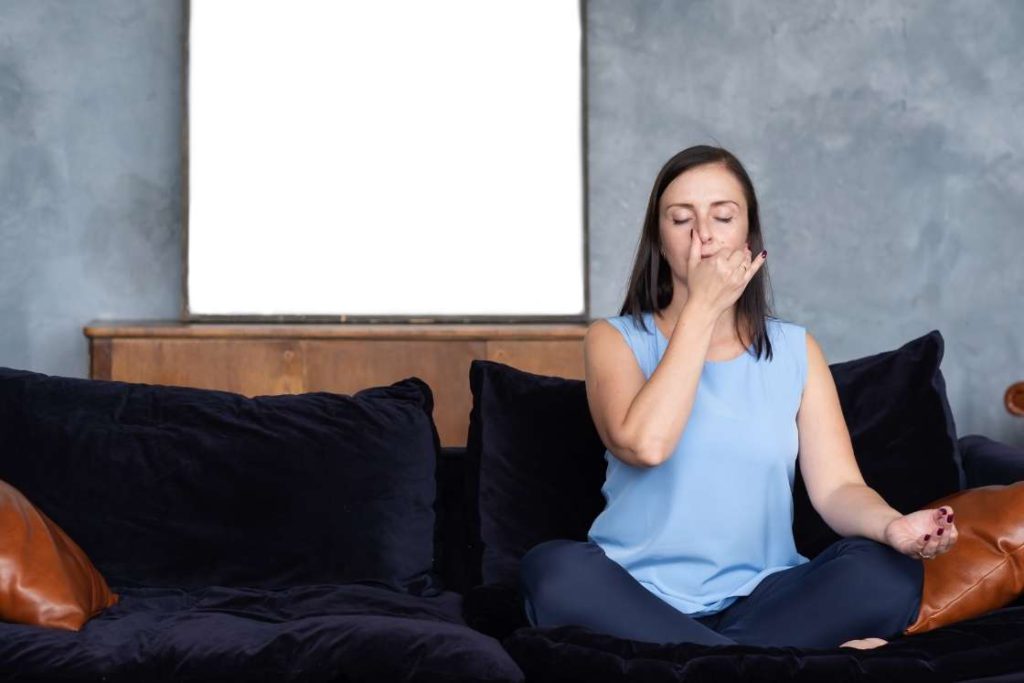
Air is inhaled through the left nostril and exhaled through the right nostril during Chandra Bhedana Pranayama, a yoga breathing practice used to cool the body and mind. It is a type of uni-nostril breathing in which inhaling and exhalation are restricted to the left and right nostrils.
Chandra bhedana pranayama cools down the body which stimulates the vagus nerve, resulting in the activation of the parasympathetic nervous system which lowers heart rate and dilates blood vessels. The parasympathetic nervous system, which lowers heart rate and dilates blood vessels, is activated by Chandra Bhedi Pranayama’s slow, deep breathing which, consequently, lowers overall blood pressure.
Steps to perform
- Sit comfortably for meditation, trying to keep your back as straight as you can.
- Put your left hand in the Gyan mudra position on your thigh. Your right hand should be brought up close to your face.
- Fold the index and middle fingers while placing the thumb on the right nostril. Place the ring and little finger close to the left nostril.
- For a few seconds, breathe normally to steady your breath.
- Close your right nostril with your thumb and breathe in via your left nostril.
- Breathe out entirely from the right nostril while closing your left nostril.
- This completes one round of the pranayama.
- Repeat the process 3-5 times.
4. Sitali Pranayama (Cooling Breath)
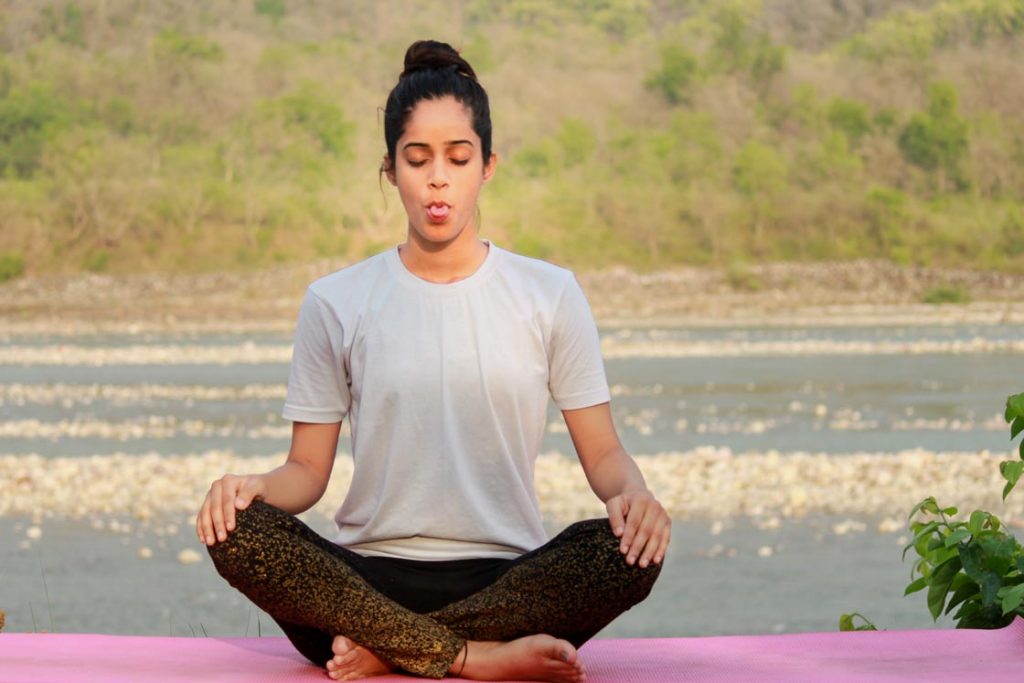
Sitali pranayama is another cooling breathing technique helpful in lowering tension and anxiety, controlling blood pressure, and promoting a calm and tranquil mind.
In 2020, research published its finding noting that in patients with hypertension, sitali pranayama significantly lowers blood pressure and improves heart rate variability. Thus, for the effective management of hypertension, sitali pranayama could be used in addition to conventional medicine.
Steps to perform
- Sit comfortably for meditation, trying to keep your back as straight as you can. If sitting on the floor bothers you, you can sit on a cushion, a folded blanket, or a chair.
- Open your mouth and take three deep breaths while exhaling through your nose to regulate your breathing.
- As though holding a straw, make an “O” shape with your mouth.
- You should have your tongue curved at the sides and slightly extending from your mouth. In the event that you can’t roll it, it can also stay flat.
- Inhale deeply and allow the chilly air to run through your mouth and throat as if you were sipping through a straw.
- To let the warm air out, slowly exhale through your nose while keeping your lips closed and your tongue within.
- Practice this pranayama for 2-3 minutes.
Which pranayama is not good for high blood pressure?
Although pranayama is safe to practice but certain types of pranayama should be avoided if you’re suffering from high blood pressure.
Pranayama which involves a high rate of breathing i.e. ‘higher number of breaths per minute than normal breath rate’, is not a good option for high blood pressure. For example, Kapalbhati and Bhastrika pranayama. In kapalbhati, the breath rate goes up to 30 breaths per minute while our normal breath rate is 10 to 12 breaths per minute.
Kapalbhati and bhastrika pranayama is not safe for high blood pressure because in these pranayamas exhalations are short and rapid. It means more carbon dioxide is expelled from the body which results in more oxygen in the system. When we inhale more air than exhale, it can narrow the blood vessels and decrease blood circulation.
Those with high blood pressure must practice Kapalbhati under the supervision of a trained and experienced Yoga teacher. Bhastrika pranayama for high blood pressure must also be practised at a slow pace under an experienced yoga teacher.
Conclusion
If you are vigilant and take precautions, you can easily prevent contracting or reduce the problem of high blood pressure. Regular check-ups, self-monitoring, eating healthy, and performing pranayama can go a long way to help you in regulating your blood pressure.
